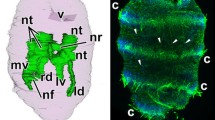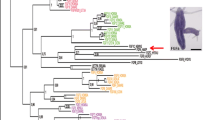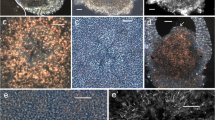Summary
Asexual, non-budding hydras were treated in the 1∶75000 solution of E 39 solubile (Bayer). They were feeding, growing and budding for six days. The interstitial cells found in the ectoderm at the moment of treatment differentiated into cnidoblasts during that period. The cells that happened to be in the gastroderm at that time, differentiated into interstitial cells which were not able to cross the mesoglea due to the E 39 activity. In the gastroderm a great number of cnids appeared.
These observations support the hypothesis that in normal hydra the interstitial cells formed by the dedifferentiation of gland cells pass into the ectoderm. There they are transformed into cnidoblasts which pass into the mesoglea. Prom the gastroderm the cnidoblasts come into the ectoderm of the tentacles through endodermal cells and the coelenteric fluid.
Zusammenfassung
Asexuelle, knospenlose Hydren wurden mit einer Lösung von „Bayer E 39 (1∶75000), solubile“ behandelt. Einige Tiere wurden nach 4, 6, 10 und 24 Std fixiert, die übrigen nach 24 Std in das Aquariumwasser zurückversetzt. Diese Hydren wurden in Zeitabschnitten von 24 Std innerhalb von 8 Tagen fixiert.
Im Verlauf der ersten 6 Tage fressen und wachsen alle Hydren und bilden Knospen. Am 7. Tag (bei einigen am 8. Tag) beginnt die Depression: Die Nahrungsaufnahme hört auf, die Polypen kontrahieren sich allmählich und ihre Tentakel verkürzen sich. Bis zum 16. Tag sind alle Hydren eingegangen. In den ersten Stunden nach der Behandlung (bis zu 10 Std) sind imEktoderm fast gar keine Veränderungen zu bemerken, imGastroderm kommt es jedoch zu Veränderungen in der Größe, Form und im Bau der zymogenen Zellen. Nach dem 1. Tag verschwinden die interstitiellen Zellen allmählich, aber die Cnidoblasten und die Cniden verbleiben vollzählig bis zum 7. Tag, dann aber nimmt die Zahl der Cnidoblasten ab. In geringerer Zahl bleiben jedoch die Cniden bis zum Lebensende erhalten. Die zymogenen Zellen dedifferenzieren sich zu interstitiellen Zellen, einige unter ihnen verwandeln sich in kleine kugelförmige, ausgesprochen basophile Zellen, welche sich an der Mesogloea ansammeln.
Am Anfang, wenn E 39 noch nicht zu voller Wirkung gekommen ist, durchwandern interstitielle Zellen die Mesogloea und gliedern sich in das Ektoderm ein. Dieser Zellübergang nimmt allmählich ab, hört aber niemals vollkommen auf. Während dieser Zeit häufen sich immer mehr reife Cniden im Gastroderm an. Die Autoren sind der Meinung, daß es sich hierbei um Cniden handelt, die sich einerseits aus jenen Cnidoblasten entwickelt haben, die am Anfang der Behandlung aus dem Ektoderm in das Gastroderm eingewandert sind, andererseits von interstitiellen Zellen abstammen, die durch Dedifferenzierung aus zymogenen Zellen entstanden und im Gastroderm übriggeblieben sind. Sie entwickelten sich dort, weil sie infolge der Wirkung von E 39 weder durch die Mesogloea hindurchtreten, noch in die Tentakel einwandern konnten. Diese Prozesse werden in der Arbeit ausführlich diskutiert.
Auf Grund dieser Beobachtungen nehmen die Autoren an, daß auch in der normalen Hydra die aus zymogenen Zellen entstandenen interstitiellen Zellen in das Ektoderm einwandern, wo sie sich teilen und zu Cnidoblasten ausdifferenzieren.
Ein Teil dieser Cnidoblasten wandert durch die Mesogloea in das Gastroderm ein, aber aus dem Gastroderm mittels entodermaler Zellen und gastraler Flüssigkeit wieder aus und gelangt schließlich in das Ektoderm der Tentakel.
Similar content being viewed by others
References
Breslin-Spangenberg, D., andR. E. Eakin: Histological studies of mechanismus involved in Hydra regeneration. J. exp. Zool.151, 85–94 (1962).
Burnett, A. L., E. Davis, andF. E. Ruffing: A histological and ultrastructural study of germinal differentiation of interstitial cells arising from gland cells in Hydra viridis. J. Morph.120, 1–8 (1966).
Diehl, F. A., andA. L. Burnett: The role of interstitial cells in the maintenance of Hydra. I. Specific destruction of interstitial cells in normal, asexual, non-budding animals. J. exp. Zoll.155, 253–260 (1964).
—: The role of interstitial cells in the maintenance of Hydra. II. Budding. J. exp. Zool.158, 283–298 (1965).
—: The role of interstitial cells in the maintenance of Hydra. III. Regeneration of hypostome and tentacles. J. exp. Zool.158, 299–318 (1965).
—: The role of interstitial cells in the maintenance of Hydra. IV. Migration of i-cells in homografts and heterografts. J. exp. Zool.163, 125–140 (1966).
Gauthier, G. F.: Cytological studies on the gastroderm of Hydra. J. exp. Zool.152, 13–39 (1963).
Haynes, J., andA. L. Burnett: Dedifferentiation and redifferentiation of cells in Hydra viridis. Science142, 1481–1483 (1963).
Jones, C. S.: The place of origin and the transporration of cnidoblasts in Pelmatohydra oligactis. J. exp. Zool.87, 457–475 (1941).
Kepner, W. A., B. D. Reynolds, L. Goldstein, andJ. H. Taylor: The structure, development and disharge of the penetrant of Pelmatohydra oligactis (Pall.). J. Morph.72, 561–588 (1943).
Lui, A., u.D. Žnidarić: Das Gastroderm im Process der Regeneration der Hydra. Wilhelm Roux' Archiv160, 1–8 (1968).
Müller, W.: Differenzierungspotenzen und Geschlechtsstabilität der i-Zellen von Hydractinia echinata. Wilhelm Roux' Arch. Entwickl.-Mech. Org.159, 412–432 (1967).
Nörmandin, D. K.: Regeneration of Hydra from the endoderm. Science132, 678 (1960).
Shostak, S., G. Patel, andA. L. Burnett: The role of mesoglea in mass cell movement. Develop. Biol.12, 434–450 (1965).
—, andM. Globus: Migration of epitelhiomuscular cells in Hydra. Nature (Lond.)210, 218–219 (1966).
—, andD. R. Kankel: Morphogenetic movements during budding in Hydra. Develop. Biol.15, 451–463 (1967).
Slauttenback, D. S., andD. W. Fawcet: The development of the cnidoblasts in Hydra. J. biophys. biochem. Cytol.5, 441–452 (1959).
Tardent, P.: Axiale Verteilungs-gradienten der interstitiellen Zellen bei Hydra und Turbellaria und ihre Bedeutung für die Regeneration. Wilhelm Roux' Arch. Entwickl.-Mech. Org.146, 393–469 (1954).
Wood, R. L.: Intercellular attachment in the epithelium of Hydra as revealed by electron microscopy. J. biophys. biochem. Cytol.6, 343–352 (1959).
Author information
Authors and Affiliations
Rights and permissions
About this article
Cite this article
Žnidarić, D., Lui, A. Dedifferentiation of gland cells in hydra and further development of interstitial cells arising from them. W. Roux' Archiv f. Entwicklungsmechanik 162, 374–383 (1969). https://doi.org/10.1007/BF00578702
Received:
Issue Date:
DOI: https://doi.org/10.1007/BF00578702




